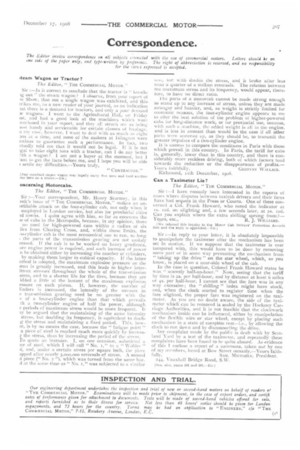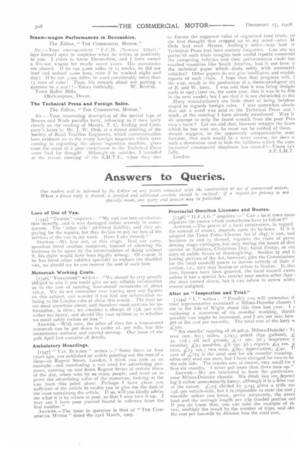Correspondence.
Page 19

Page 20

If you've noticed an error in this article please click here to report it so we can fix it.
iteam Wagon or Tractor ?
The Editor, "THE COMMERCIAL Morost."
Sir :—ls it correct to conclude that the tractor knock
ig out " the steam wagon? 1 observe, from your report of :le Show, that not a single wagon was exhibited, and this trikes me, .hs a new reader of your journal, as an indication tat there is a demand for tractors, and only a poor demand >r wagons. I went to the Agricultural lIall, on Friday 1st, and had a good look at the machines. V;ltich were )en tioned in your report, and they all struck me as being lost handy and serviceable for certain classes of haulage. n iiiv case, however, I want to deal with as much as eight arts at a time, and none of the makers at Islington were nxious to guarantee such a performance, In face two ctually told me that it would not be legal. If it is not gal to take eight tons with a tractor, can I do any better ,ith a wagon? I am not a buyer at the moment, but 1 .ant te get the facts before me, and I hope you will be able ) settle my difficulties.—Yours truly, " Cos-macron."
[any standard steam wagon may legally carry fire on and Inini another re, tore on a trailer.—Eo.j
onceraing Motorcabs.
The Editor, "THE COMMERCIAL MOTOR."
Sir :—Your correspondent, Mr. Henry Sturmey, in this eek's issue of "THE COMMERCIAL MOTOR," makes an unistifiable attack on the four-cylinder cab, not only when it employed in London service, but also for provincial cities Id towns. I quite agree with him, so far as concerns the
of cabs in the Metropolis, because, in my opinion, there no need for high-powered cars within a radius of six iles from Charing Cross, and, within those limits, the as-cylinder cab is the most economical one to run, so lone the parts of the transmission gearing are not unduly ressed. If the cab is to be worked on heavy gradients, ore engine power is required, and such increase of power .n be obtained either by increasing the number of cylinders, by making them larger in cubical capacity. If the latter ethod is adopted, the maximum explosion pressure on the ston is greatly increased, and this leads to higher interWent stresses throughout the whole of the transmission stem, and to a shorter life for the tires, because they are :idded a little at the instant of the maximum explosion ensure on each piston. If, however, the number of hinders is increased, the intensity of the stresses in C transmission gearing need be no greater with the e of a four-cylinder engine than that which las:wails th a two-cylinder engine of half the power, although e periods of maximum stress would be more frequent. It ay be argued that the maintaining of the same intensity stress, but doubling its frequency, is equivalent to daub.g the stress and maintaininga fixed period. This, hewer, is by no means the case, because the " fatigue point a piece of steel is reached much more quickly by increasz the stress, than by increasing the period of the .stross. To quote an instance. I, on one occasion, submitted a ce of steel. which I will call " No. z," to a " Wobler
and under a certain stress per square inch, the piece apped after nearly 5,000,000 reversals of stress. A second
A piece (" No. 2 which was turned from the same bar. d at the same time as " No. t," was subjected to a similar 1t:, Out viih double the stress, and it broke after less man a quarter of a million reversals_ The relation between tne maximum stress and its frequency, would appear, therefore, to have no direct ratio.
'1 he parts of a motorcab cannot be made strong enough to stand up to any increase of stress, unless they are made stronger and heavier, and, as weight is strictly limited for economic reasons, the four-cylinder engine appears to Inc to otter the best solution of the problem of higher-powered cabs for long-distance work, or ior provincial use, aecause, with such a machine, the added weight is all in the engine. and is less in amount than would be the case if all other parts were stmened up, as they should be, to transmit the greater impulses of a two-cylinder engine.
It is useless to compare the conditions in Paris with those which prevail in this country. In Paris, the tariff for cabs is, generally, lower than in this country, and there is considerably more reckless driving, both of which factors tend towards the reduction or the disappearance of profits.— Yours faithfully, GEOFFHV WALLACE. lith December, teoS.
Can a Taximeter Lie?
The Editor, "TILE COMMERCIAL MOTOR," Sir :—I have recently been interested in the reports of cases where disputes between taxicab drivers and their fares have had sequels in the Press or Courts. One of these concerned a Col. Frank Howard, who noted the indicator at iod. on alighting and, a few seconds later, at 25. rod. Can you explain where the extra shilling sprung from?— Yours, etc., R. J. WILLIAMS. INVe referred thh, inquiry to the Motor Cab Drivers' Protection Associa
Lion and the reply is appended.-En-I
Sir :—In reply to your letter, it is absolutely impossible to manipulate the taximeter after the mechanism has been set in motion. If we suppose that the taximeter is ever tampered with, this would have to be done by removing some part or in some way preventing the mechanism from " taking up the drive" on the star wheel, which, as you know, is placed on a near-side wheel of the cab.
In the case in question, Colonel Frank Howard states he was t' scarcely half-an-hour." Now, seeing that the tariff by time is 25. per half-hour, and by distance at least 6 miles or 4s. per half-hour, I cannot see that the fare was in any way excessive ; the "shilling " index might have stuck, and, when the clock started to register time when the fare alighted, the proper fare was registered on the taximeter, As you are no doubt aware, the side of the taximeter which can be removed is sealed by the Hackney Carriage Authorities, and it is not feasible that the clockwork mechanism inside can be influenced, either by manipulation of the flexible wire or star wheel, except by placing such mechanism in a state of complete rest-1,e., by allowing the clock to run down and by disconnecting the drive. Any complaint made by the public is dealt with by Scotland Vard by a test of the taximeter, and repeatedly these complaints have been found to be quite absurd. As evidence of this I enclose a report of a summons, taken out by one of my members, heard at Bow Street recently.—Yours faith
li
Si. MICHAELS, President. Si. MICHAELS, President.
244, Vauxhall Bridge Road, S.W. (see, also, pages 591 and 301.—ELL.) The Editor, " THE COMMERCIAL MOTOR."
Sir :—Your correspondent " F.C.H. (Newton Abbot) " lays himself open to suspicion when he writes so positively to you. I claim to know Devonshire, and I have owned a five-ton wagon for nearly seven years. His statements are absurd. If he ran 3,000 miles in ts weeks, he did not load and unload 2,000 tons, even if he worked night and day! If he ran 3,000 miles, he used considerably more than 13 tons of coke ! Then, his remark about not putting a
spanner to a nut ! !—Yours faithfully, W. ROWSE, Town Roller Mills,
Okehampion, Devon.
The Technical Press and Foreign Sales.
The Editor, " TIM COMMERCIAL MOTOR."
Sir :—Your interesting description of the special type of Broom and Wade paraffin lorry, following as it does fairly closely on the reading of Messrs. T, C. Aveling and Company's letter by Mr. J. W. Orde at a recent meeting of the Society of Road Traction Engineers, which communication bore evidence as to the many foreign enquiries which were coming in regarding thc above ingenious machine, gives even the mind of a poor contributor to the Technical Press some food for thought. Although an outsider, I intruded at the recent meeting of the S.M.T.E., vhen they met
to discuss the supposed value of organised road trials, an the first thought that cropped up in my mind—after M Orde had read Messrs. Aveling,'s letter—was how ti Technical Press had been entirely forgotten. Can any sui
porter-of such trials imagine how useful reports concernin the competing vehicles and their performances could haN
reached countries likeSouth America, had it not been f( the technical paper which deals solely with commerci vehicles? Other papers do not give intelligent and readah reports of such trials. I hope that that progress will, I the way, result in the production of a three-speed-gear tyl of B. and W. lorry. I was told that it was being design( early in 1907; later on, the same year, that it was to be fitt( in the next model ; but I sea: that it is not chronicled to dat Many manufacturers are little short of being helpless stupid as regards foreign sales. I was somewhat shock( that not a word was said re the Technical Press and i work, at the meeting I have already mentioned. Was it sty attempt to strip the laurel wreath front the poor Pres man's brow? Let me add that, however meagre the Inure which he has won are, he must not be robbed of them.
should suggest, to the apparently unappreciative man• facturer, that such would be a sorry course, for does n such a decoration tend to hide the baldness which the man facturers' commercial sleepiness has caused ?—Yours fait fully, A.E.A.M.T. London.






















